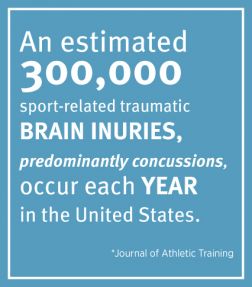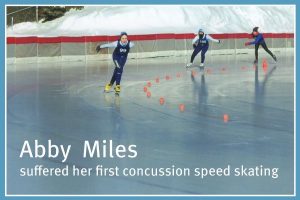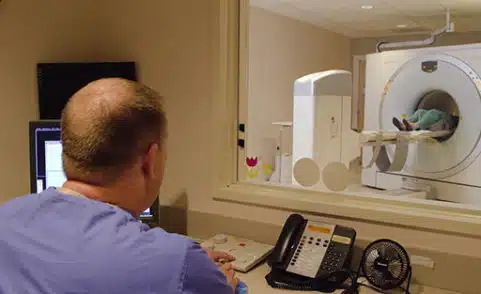
Concussion Movie Sheds Light on Dangers for Younger Athletes


From professional football player suicides to tragic deaths on the high school and college fields, Dr. Blake Johnson, RAYUS Director of Neuroimaging, says all the attention to brain injury has sparked progress. More concussions are being reported – not necessarily because there are more, he says – but because of increased awareness:
“The adage that it’s a sign of weakness if you can’t play if you’ve got your bell rung is recognized as very dangerous. If you’ve had a concussion and now you’re back on the field and get a second concussion, it can be very dangerous or even fatal.”
How a Concussion Changes Your Life
Like a lot of teenagers, Abby Miles loved speed. Lacing up her skates, she found her outlet on the ice. She was at speed skating practice when, rounding a corner on a relay, she wiped out. Abby doesn’t remember much about the crash but says that afterward:
“The coaches, they took me out for the rest of practice and they gave me an ice pack and they called my Mom and they told me to rest and they’d see me when I felt better.”
But she didn’t feel much better. She went from sleeping six hours a night to needing fifteen hours of rest. Her once-glowing grades began to drop because Abby says she just couldn’t remember anything. While most kids’ concussions are resolved within two weeks, Abby’s was slow to heal. Finally, a month later, her symptoms were starting to go away when her family was in a car crash going 60 miles an hour. Abby remembers her head hitting the window.
The sensitivity to light, confusion, tiredness, irritability, memory loss – all were things Abby’s mom Mary Miles began to notice in her daughter. She knew they were signs of a brain injury. “I don’t think in my mind I put concussion as a mild brain injury until we went through the whole experience and realized that not everybody recovers from a concussion,” Mary explains. “Your brain can be permanently damaged from it and I think that’s a big thing that I learned seeing Abby not really recover from everything.”
According to research reported in the Journal of Athletic Training, an estimated 300,000 sport-related traumatic brain injuries, predominantly concussions, occur each year in the United States. And among young people ages 15-24, sports are the second leading cause of traumatic brain injury (topped only by car crashes). Abby had both in the span of a month and they forever changed her life.
Concussion Laws in all 50 States
Since 2009, all 50 states have adopted some sort of concussion laws for youth sports, though the scope of these laws varies greatly from state to state. When Susan Sipe’s daughter got her first concussion at a soccer game, her state of Minnesota had yet to pass regulations. In fact, Susan says even the doctor wasn’t well versed in concussion protocol.
“One of the biggest things I remember is when we went to our pediatrician she actually had to pull out a three-ring binder. As I recall it was dusty. Now I might be over-exaggerating things, but literally, that dusty binder was their concussion protocol.”
An advocate now for concussion awareness, Susan supports other families dealing with sports-related concussions and is actively involved with the Minnesota Brain Injury Alliance. The organization’s Executive Director David King has worked hard to get concussion legislation passed in Minnesota for young athletes. He says the national attention placed on the issue has really helped the cause. “Just the whole way we look at concussions is completely different than even we did five years ago.”
Even though King says many of the state laws don’t have “much teeth”, he says awareness was always the point behind the legislation:
“It wasn’t penalizing people and catching them in the act. Really we wanted folks, we wanted coaches, we wanted players, parents, referees, to all be acutely aware of the signs, the symptoms, and the seriousness of concussions so we could get kids off the field when they experienced concussions.”
What Parents of Young Athletes Need to Know
Since only about 10% of concussions result in loss of consciousness, parents need to know what signs to look for to identify a concussion. Symptoms can be:
-Cognitive (poor memory, trouble concentrating)
-Emotional (anxiety, depression, impulse control)
-Physical (headaches, dizziness, fatigue)
RAYUS’s Dr. Johnson says even if you can identify the symptoms, it can be hard to ignore the pressure to play. Whether it’s getting your little leaguer back on the diamond or your hockey forward back on the ice for the championship game, the pressure can be intense. “If you don’t educate the parents, they don’t know that their kid that just took a helmet to the boards or to the ice and had a dazed period of time had a concussion,” Dr. Johnson explains. But by encouraging a kid to get back out there, “They’re at risk of a significant injury to their head or the rest of their body. So, the education is extremely important. You can’t just rely on the physician in the ER to know about this because when they get to the ER, it’s too late.”
The passing of laws has helped put in place protocols for sports leagues and school athletic programs. And those protocols have helped to educate parents about concussion recovery. King says two questions parents need to consider are:
-When is it safe for my child to return to play without aggravating the symptoms or prolonging recovery?
-What kind of emotional impact can I expect during recovery as my child is isolated from peers and may be dealing with anxiety or depression?
That second question was something Abby and her mom weren’t expecting. Abby’s concussions took a toll on her socially as much as academically. Mary Miles remembers watching Abby’s friends fall away. “All I wanted to see was her to be happy again and find something that gave her joy in life again,” says Mary. Today, Abby has accomplished that and much more. With a lot of help and an incredible amount of perseverance, Abby not only finished high school, she went on to college where she’s studying to be a physical therapist. Her advice for other kids who hit their head playing sports is simple:
“You want to go back in and you want to play, you want to think that you’re fine, but you’re really not and you should sit out and just give your brain the rest that it needs.”
For more information on signs and symptoms of concussion and when to turn to medical imaging for answers, read this blog.

